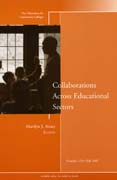
INDICE: EDITORS NOTES (Marilyn J. Amey). 1. Demands for Partnership and Collaboration in Higher Education: A Model (Marilyn J. Amey, Pamela L. Eddy, C. Casey Ozaki) This chapter describes a model that can serve as a lens for examining community college partnership with a host of organizational collaborators,including the overall potential for achieving intended outcomes, sustainability, and partner benefits. PART ONE: Case Studies. 2. Seamless Transition in the Twenty-First Century: Partnering to Survive and Thrive (Gail Hoffman-Johnson) This chapter describes development and implementation of a strategic partnership between a community college and a premier engineering university to improve students transition from the two-year to the fouryear institution. 3. Partnering to Move Students into College and Community-Oriented Careers: The Administration of Justice Department at East Los Angeles College (Carrie B. Kisker, Patrick Hauser) This chapter describes how the Administration of Justice Department at East Los Angeles College has partnered with community and educationalorganizations to move students into college and careers in law enforcement, criminal justice, and the fire service. 4. The Importance of Language, Context,and Communication as Components of Successful Partnership (Susan J. Bracken) Successful community-university partnerships are usually attributed, at least in part, to clear communication processes. This chapter reflects on language and context as elements in developing a strong partnership process. 5. SteppingOutside the Big Box High School: A Partnership Influenced by Goals, Capital, and Decision Making (Jesse S. Watson) This chapter describes a partnership among a K12 school district, a community college, and a four-year university. It focuses on the role that capital in various forms plays in the partnership. PART TWO: Less-Than-Successful Experiences. 6. Alliances Among Community Colleges: Odd Bedfellows or Lasting Partners? (Pamela L. Eddy) This chapter discussesthe experience of five two-year colleges that formed a statewide alliance. Itdetails how the motivation for joining the alliance varied among the college leaders and describes the challenges the partners faced. 7. Lessons Learned from a Dual-Enrollment Partnership (Patricia L. Farrell, Kim Allan Seifert) Thischapter presents lessons learned from a community college in Arizona when implementing dual-enrollment partnership programs. 8. A Partnership in Flux: The Demise of a Program (Gay Garland Reed, Joanne E. Cooper, Llewellyn Young) Thischapter explores issues surrounding the demise of a masters program, the Interdisciplinary Master in Education (IMED), that was delivered on the neighbor islands in the state of Hawaii. The innovative program brought educational opportunities to remote areas of the state and was a partnership between the main campus in Honolulu and several community colleges. PART THREE: Other Perspectives on Educational Partnership. 9. The Legislative Playing Field: How Public Policy Influences Collaboration (Debra D. Bragg, Maxine L. Russman) This chapter discusses collaboration associated with four public policies at the federal and state levels to show how partnerships are encouraged and how they struggle. The chapter concludes with lessons learned about the complex intersection between policy and practice. 10. Strategies for the Future (C. Casey Ozaki, Marilyn J. Amey, Jesse S. Watson) This chapter revisits the partnerships describedin this volume, using the model outlined in Chapter One and introducing social and organizational capital as a largely ignored factor in the development and sustainability of partnerships. INDEX.
- ISBN: 978-0-470-25524-7
- Editorial: John Wiley & Sons
- Encuadernacion: Rústica
- Páginas: 112
- Fecha Publicación: 02/04/2008
- Nº Volúmenes: 1
- Idioma: Inglés
